Apple's iPhone 4: Thoroughly Reviewed
by Brian Klug & Anand Lal Shimpi on June 30, 2010 4:06 AM EST- Posted in
- Smartphones
- Apple
- iPhone 4
- Gadgets
- Mobile
I'm not sure how this keeps happening. The first year I waited at a mall for 5 hours to get the original iPhone. The following year my friend Mark Rein convinced me to see a midnight showing of Hellboy II and then wait outside of an AT&T store all night to get the iPhone 3G. You'd think I'd learn by the third year but once more I was in line at the mall hours before the Apple store opened to get the 3GS. This year I thought it would be different. Apple offered free overnight shipping to anyone who wanted to pre-order the iPhone 4. Figuring everyone would go that route I decided to beat the FedEx trucks and just show up at the mall at 6AM. I'd be in and out in a little over an hour, which would give me a head start on battery life testing on Apple's 4th generation iPhone.
I promise that not all of my decisions play out this poorly. Those who pre-ordered the 4 and requested overnight delivery got their phones early and my one hour wait turned into six hours at the mall, for the fourth year in a row.
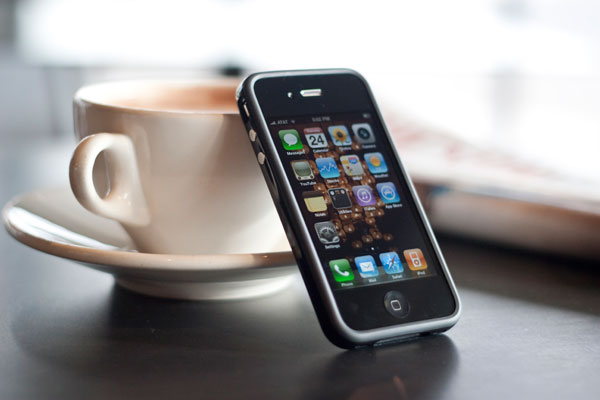
Apple's iPhone 4 with Bumper Case
It's a self fulfilling prophecy. Steve gets up on stage, proclaims the iPhone 4 to be the biggest introduction since the original iPhone, and the public flocks to Apple stores to fork over $200 on day one and around $2500 over the course of two years for the privilege. But this isn't 2007. Apple has real competitors in the smartphone space. Android phones have grown in features, polish and popularity. Even Palm entered the race with a competant offering, and Microsoft isn't far behind. It's easy to start a revolution when everyone else is doing the wrong thing, but what about when more companies actually get it? Was Steve justified in his excitement over the 4? That's what we're here to find out today.
Straight on it looks like just another iPhone. You get the black face with a shiny trim. From the side it is the redesign that Apple has needed for a while now. It’s not revolutionary but it’s the type of improvement that makes its predecessor feel old. And that’s exactly what this does. Have a look for yourself:
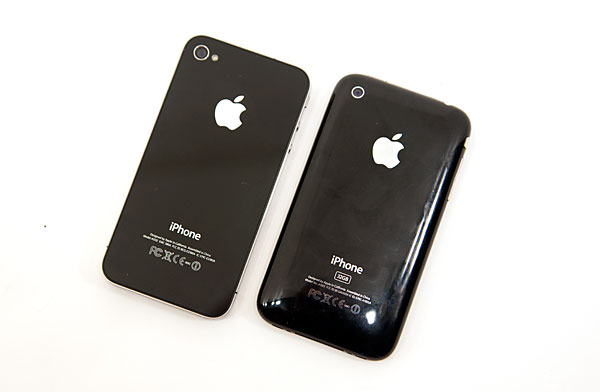
iPhone 4 (left) vs. iPhone 3GS (right)
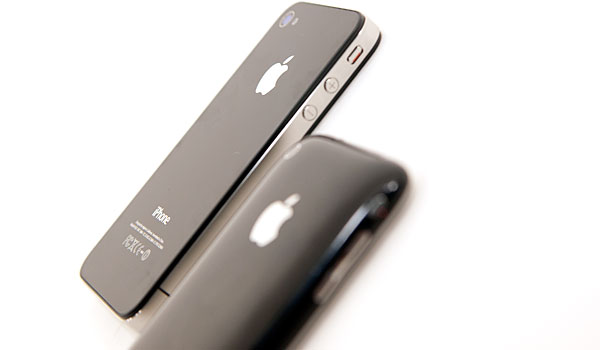
The straight lines, smaller dimensions and lack of unnecessary bulk make the 3GS feel like a car from the 90s, unnecessarily curvy. The styling is now so much more compact. Compared to the iPhone 3GS the 4 is around 5% narrower (but no more difficult to type on) and nearly 25% thinner. It even makes the Nexus One look dated:
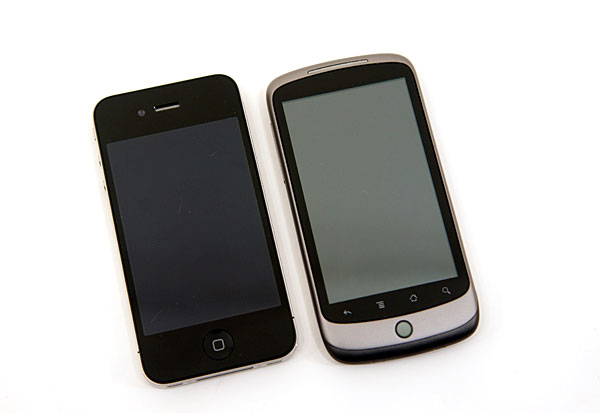
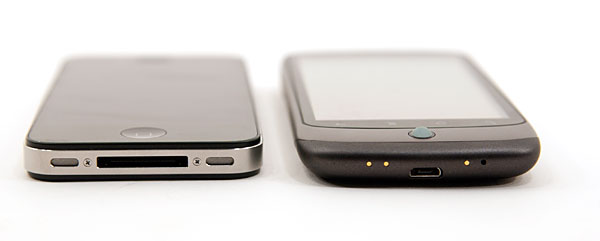
The iPhone 4 is slightly heavier than the 3GS (4.8oz vs. 4.7oz). You feel the added weight but I wouldn't call it heavy. The front and the back of the iPhone 4 are both made out of glass, and they protrude beyond the stainless steel band that wraps around the phone (more on this controversial decision later). While this gives the 4 an amazing finish, it also makes carrying the phone nerve racking. Coupled with the smaller, more dense form factor I’m now deathly afraid of dropping and shattering this thing. Apple has done a lot to reinforce the glass, however there have been enough reports already of shattered iPhone 4s for me not to feel very safe. Only Apple would think to make the two surfaces most likely to hit something out of glass. It's like making mouse traps out of cheese, something bad is bound to happen.

iPhone 4 (left) vs. iPhone 3GS (right)
The physical buttons (but not their layout) have changed on the 4. The ringer switch has shorter travel and feels sturdier as a result. The volume rocker has been replaced by discrete volume up/down buttons, also very sturdy in feel. The power/lock button is also now made out of stainless steel. Only the home button remains unchanged, although it does seem to make a deeper click when you use it.

The speaker moved to behind the right grill at the bottom of the phone instead of the left. The dock connector thankfully remained unchanged. It looks like Apple is committed to maintaining this connector until it makes the jump to something wireless (or optical?).

The back of the phone is pretty. Apple broke with tradition and finally included a single LED flash on the phone. The flash comes on in low light conditions and is enough to take shots in total darkness.
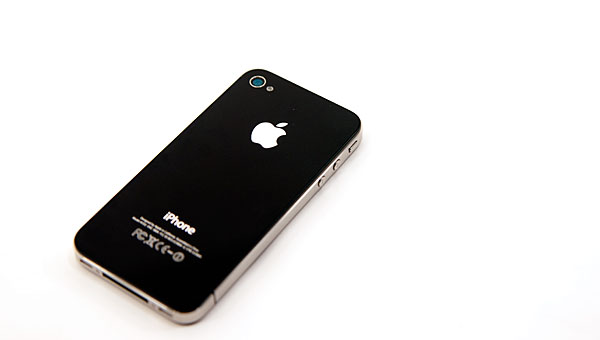
The camera has been upgraded to a low noise 5MP sensor. It can shoot stills at up to 2592 x 1936 or video at 1280 x 720 @ 30 fps. We’ll go into greater detail on its quality in the camera section. The iPhone 4 also adds a front facing camera capable of shooting both photos and video at 640 x 480.
Apple quotes contrast ratio as 1000:1, in our measurements we got very close (952:1). A significant improvement over the 188:1 ratio of the 3GS. Apple achieved this by both dropping black levels and increasing the white levels on the display. Improving both is always fine by me.
Internally the iPhone 4 uses Apple's new A4 SoC, built around an ARM Cortex A8 CPU and a PowerVR SGX GPU. The new SoC is built on a 45nm process and features 512MB of memory on the package. Apple hasn't made CPU clock speed public, but I'm guessing around 800MHz compared to the iPad's 1GHz for reasons you'll see later. GPU clock speed is unknown as well. Having more memory on package is an interesting move by Apple as it makes the iPhone 4 better suited for multitasking compared to the iPad. Also implying that shortly after the iPad gets multitasking it'll be updated to a version with more memory as well.
The iPhone now has an gyroscope as well the rotation sensors of its predecessors. Developers are given full access to the gyroscope making the iPhone 4 capable of becoming a very expensive Wii-mote.
| Physical Comparison | ||||||||
| Apple iPhone 4 | Apple iPhone 3GS | HTC EVO 4G (Qualcomm Snapdragon QSD8650) | HTC Droid Incredible (Qualcomm Snapdragon QSD8650) | Google Nexus One (Qualcomm Snapdragon QSD8250) | ||||
| Height | 115.2 mm (4.5") | 115 mm (4.5") | 121.9 mm (4.8") | 117.5 mm (4.63") | 119 mm (4.7") | |||
| Width | 58.6 mm (2.31") | 62.1 mm (2.44") | 66.0 mm (2.6") | 58.5 mm (2.30") | 59.8 mm (2.35") | |||
| Depth | 9.3 mm ( 0.37") | 12.3 mm (0.48") | 12.7 mm (0.5") | 11.9 mm (0.47") | 11.5 mm (0.45") | |||
| Weight | 137 g (4.8 oz) | 133 g (4.7 oz) | 170 g (6.0 oz) | 130 g (4.6 oz) | 130 g (4.6 oz) | |||
| CPU | Apple A4 @ ~800MHz | Apple/Samsung A3 @ 600MHz | Qualcomm Scorpion @ 1GHz | Qualcomm Scorpion @ 1GHz | Qualcomm Scorpion @ 1GHz | |||
| GPU | PowerVR SGX 535 | PowerVR SGX 535 | Adreno 200 | Adreno 200 | Adreno 200 | |||
| RAM | 512MB LPDDR1 (?) | 256MB LPDDR1 | 512MB LPDDR1 | 512MB LPDDR1 | 512MB LPDDR1 | |||
| NAND | 16GB or 32GB integrated | 16 or 32GB integrated | 8GB micro SD | 8GB micro SD | micro SD | |||
| Camera | 5MP with LED Flash + Front Facing Camera | 3MP | 8MP with dual LED Flash + Front Facing Camera | 8MP with LED Flash | 5MP with LED Flash | |||
| Screen | 3.5" 640 x 960 LED backlit LCD | 3.5" 320 x 480 | 4.3" 480 x 800 | 3.7" 480 x 800 AMOLED | 3.7" 480 x 800 AMOLED | |||
| Battery | Integrated 5.254Whr | Integrated 4.51Whr | Removable 5.5Whr | Removable 4.81 Whr | Removable 5.18 Whr | |||
The iPhone 4's logic board shrinks in size thanks to further component integration, making room for a much larger battery. The 5.25Whr battery in the iPhone 4 is a 16% increase from what was in the 3GS, and 95% of what HTC put in the EVO 4G. While raw performance improved, it's clear that Apple's focus this time around was battery life. Again, we'll dive into specifics later in the review.
Moving back outside Apple surrounded the phone with a stainless steel band. This band doubles as the 3G, WiFi and Bluetooth antennas. And if you hadn't noticed, it also moonlights as a giant elephant. Let's talk about it.










270 Comments
View All Comments
philosofa - Wednesday, June 30, 2010 - link
This kind of in-depth and insightful review is exactly why I read pretty much every Anandtech article (that and a liberal workplace when it comes to browsing lol). Cheers very much Brian & Anand. Don't feel a huge urge to upgrade from my 3GS, but it does look like a pretty damn fine smartphone!quiksilvr - Wednesday, June 30, 2010 - link
Yeah, but he's holding it wrong :(medi01 - Wednesday, June 30, 2010 - link
But guys, who do you pay a fortune for these phones? If you'd buy iphone or whatever phone with 2 year contract in most of Europe you'd pay just the price of the phone over 2 years (a bit more, in case of iphones it's about 700 Euro)I mean, aren't there cheaper contracts? I could imagine, that you can't buy some models other than from mobile providers, but hey, there are other countries with online shops.
Snotling - Thursday, July 1, 2010 - link
In north America and even more in Canada, there is a lot of territory to cover and lower population density. Cellular networks need to plant antennas where there is theoretically too few users to pay for it.JimmiG - Thursday, July 1, 2010 - link
Sweden is kind of like a smaller version of Canada. Apart from the three major metro regions (Stockholm, Malmo and Gothenburg), the country is very sparsely populated. An average city is maybe 50,000 people. Yet we have extremely affordable plans by comparison.. I mean like less than $10 for a perfectly usable plan (1GB of data or so) and no more than $20 for 5GB or even Unlimited. Paying $100 a moth..geez. I barely pay that in a year.Ratinator - Friday, July 2, 2010 - link
Sorry, I think that is a bad comparison.Sweden is 2/3rd the size of the province of Saskatchewan and 9 times the population of Saskatchewan as well. You can't even compare Sweden to the province of Saskatchewan let alone Canada. You have roughly 13.5 times the population density of that province. Mind you this is probably least densely populated of the provinces (not territories) Maybe not the best example, but lets look at a better one.
You could maybe compare to Ontario (our most populated province) however, you are less than half their size with 80% of their population. When calculated out you still have almost twice the population density of our most populated province.
ABR - Monday, July 5, 2010 - link
It's pretty hard to find countries with similar population density to Canada, ranked 228 out of 239 in the world according to wikipedia. On the other hand, most of the country is inaccessible by road and I seriously doubt you are putting up cell towers in Nunavut. On the other hand Finland has half the population density of the United States and yet has similar cellular and broadband rates to Sweden. We don't know what it is with North America, whether a lack of competition, cartel agreements, or all the companies being weighed down by historical investments, but you guys do lead the world in what you pay for communications.Guspaz - Wednesday, October 12, 2011 - link
According to the CIA world factbook (yes, I use a foreign agency's site for info on my own country), 90% of Canada's population lives within 160km of the US border.If we make an estimated measurement and take the southern border's length at 6416 km, multiply that by 160 and you get an area of about a million square kilometres with a population of, adjusting for the 90%, about 31 million. That would be an actual density in that region of about 31 people per square kilometre.
That puts us in 180th place, right behind the US in 179, which has a density of 32. This is close enough to say that, within our populated region, we've got about the same population density as the US.
ripwell - Saturday, July 3, 2010 - link
Are you comparing data plans to voice and data plans? Telia was blasted when the iPhone first came out with some of the most expensive plans in the world. It's pretty amazing if you're suggesting that you can now get voice and data for just $10 a month.JimmiG - Sunday, July 4, 2010 - link
"It's pretty amazing if you're suggesting that you can now get voice and data for just $10 a month. "You rarely get pre-paid minutes here unless you really want to. You just pay about $6 a month and get billed for your minutes afterwards. In my case, it's about 10¢ per minute, but to phones on the same network, you get unlimited texts, mms's and minutes. Yes, for $6 a month. That includes most of my friends and relatives that's pretty much what I pay for voice and texts.
Then on top of that, you can add your data plan, for example 1GB a month at 6Mb is $9 (add $7.8 for 5GB at 10Mb/s).
-Or, if you really must go crazy, you can get 3,000 minutes for $65. Combined with 5GB/month at 10Mb/s, you're paying roughly $82. That's the absolute maximum. No subsidized phone, but you get over 3x more minutes than the iPhone deal and 2.5x the amount of data. The phones aren't really subsidized at all when you look at the total cost.
"You could maybe compare to Ontario (our most populated province) however, you are less than half their size with 80% of their population. When calculated out you still have almost twice the population density of our most populated province. "
But what about the US? Its population density is 32/km2 vs 20.6/km2 for Sweden. There are definitely states that are comparable in size and population density.